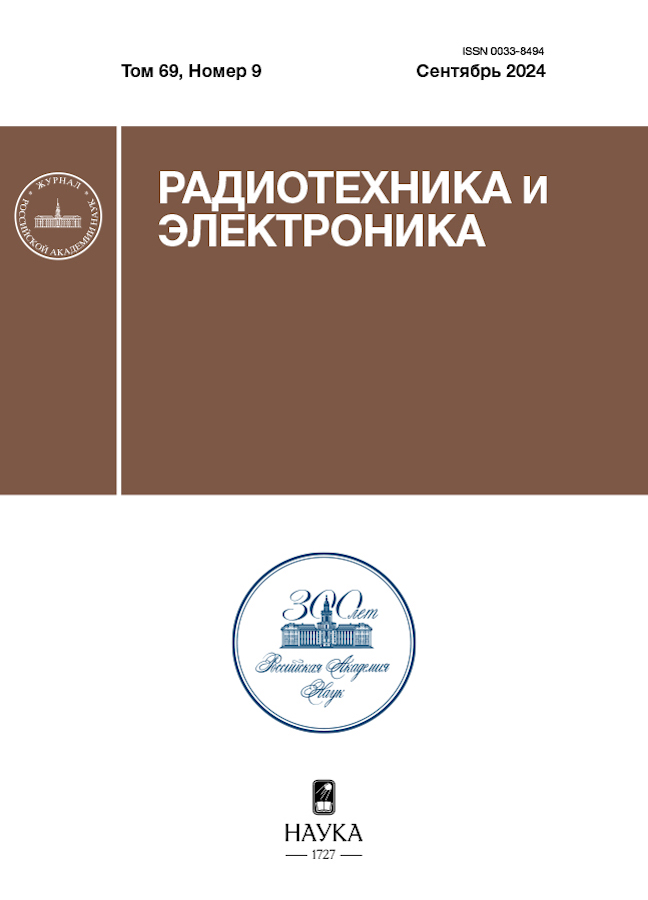Noise-immunity of optimal symbol-by-symbol reception of signals with corrective coding in Galois fields for fading channels
- Authors: Nazarov L.E.1
-
Affiliations:
- Fryazino Branch Kotelnikov Institute of Radioengineering and Electronics RAS
- Issue: Vol 69, No 9 (2024)
- Pages: 887-893
- Section: THEORY AND METHODS OF SIGNAL PROCESSING
- URL: https://genescells.com/0033-8494/article/view/683530
- DOI: https://doi.org/10.31857/S0033849424090083
- EDN: https://elibrary.ru/HRGMUA
- ID: 683530
Cite item
Abstract
A description of the algorithm for optimal symbol-by-symbol reception of signal structures based on correction coding in non-binary Galois fields is given. The results of modeling this algorithm are given in order to study its noise-immunity for transionospheric channels with fading due to scattering on ionospheric irregularities for a number of digital signals with multi-level phase shift keying in combination with a correction code with a parity check in Galois fields. It is shown that for these channels the use of a symbol-by-symbol reception algorithm provides an energy gain of up to 4.5...24 dB in relation to the reception of signals without coding.
Full Text
About the authors
L. E. Nazarov
Fryazino Branch Kotelnikov Institute of Radioengineering and Electronics RAS
Author for correspondence.
Email: levnaz2018@mail.ru
Russian Federation, Vvedenskogo Squar., 1 Fryazino, Moscow region, 141190
References
- Proakis J.G., Salehi M. Digital communication. Boston: McGraw-Hill, Higher Education, 2001.
- Bahl L.R., Cocke J., Jelinek F., Raviv J. // IEEE Trans. 1974. V. IT-20. № 3. P. 284.
- Смольянинов В.М., Назаров Л.Е. // РЭ. 1999. Т. 44. № 7. С. 838.
- Скляр Б. Цифровая связь. Теоретические основы и практическое применение. М.: ИД «Вильямс», 2003.
- Johnson S.J. Iterative Error Correction: Turbo, Low-Density Parity-Check and Repeat-Accumulate Codes. Cambridge: Univ. Press, 2010.
- Назаров Л.Е., Головкин И.В. // РЭ. 2010. Т. 55. № 10. С. 1193.
- Терешонок М.В., Кленов Н.В., Лобов Е.М. и др. // РЭ. 2022. Т. 67. № 3. С. 294. https://doi.org/10.31857/S0033849422030160.
- Назаров Л.Е., Батанов В.В. // РЭ. 2022. Т. 67 № 8. С. 782. https://doi.org/ 10.31857/S0033849422080137.
- Ping Li, Chan S., Yeng K.L. // Electronic Lett. 1997. V. 33. № 19. P. 1614.
- Steiner F., Bocherer G., Liva G. // IEEE Comm. Lett. 2018. V. 22. № 11. P. 2210.
- Lin S.-J. // IEEE Trans. 2018. V. СOM-66. № 8. P. 3235.
- Назаров Л.Е. // РЭ. 2023. Т. 68. № 9. С. 873. http://doi.org/ 10.31857/S003384942309019X
- Bourduge J., Poulliat C., Gadat B. // 2023 IEEE Int. Symp. on Information Theory (ISIT). Taipei. 25-30 Jun. N.Y.: IEEE, 2023. P. 2517. https://doi.org/10.1109/ISIT54713.2023.10206851.
- Назаров Л.Е. // Физ. основы приборостроения. 2022. Т. 11. № 3. С. 44. https://doi.org/10.25210/jfop-2203-044049.
- Питерсон У., Уэлдон Э. Коды, исправляющие ошибки. М.: Мир, 1976.
- Назаров Л.Е., Шишкин П.В. // РЭ. 2019. Т. 64. № 9. С. 910.
- Назаров Л.Е., Шишкин П.В. // Журн. радиоэлектроники. 2018. № 12. http://jre.cplire.ru/jre/dec18/10/text.pdf
- Kaipa K. // IEEE Comm. Lett. 2018. V. 22. № 11. P. 2210.
- Yeo S., Park I.-C. // IEEE Trans. 2018. V. IT-64. № 7. P. 5170.
- Crane R.K. // Proc. IEEE. 1977. V. 65. № 2. P. 180.
- Rino C.L. Theory of Scintillation with Applications in Remote Sensing. Hoboken: John Wiley & Sons, 2011.
- Ionospheric Propagation Data and Prediction Methods Required for the Design of Satellite Services and Systems. Recommendation ITU-R P.531-11. Geneva: Int. Telecommun. Union (ITU), 2012. 24 p.
- Назаров Л.Е., Смирнов В.М. // Журн. Радиоэлектроники 2020. № 11. http://jre.cplire.ru/jre/nov20/7/text.pdf https://doi.org/10.30898/1684-1719.2020.11.7.
- Назаров Л.Е., Батанов В.В. // РЭ. 2022. Т. 67. № 11. С. 1133. https://doi.org/10.31857/S0033849422110110
- Тихонов В.И. Статистическая радиотехника. М.: Сов. радио, 1966.
Supplementary files














